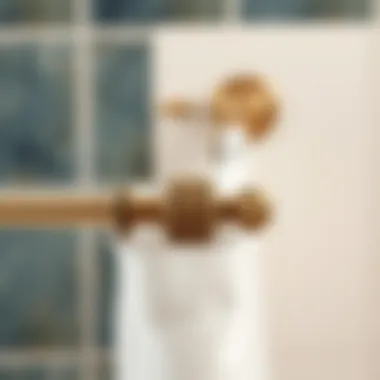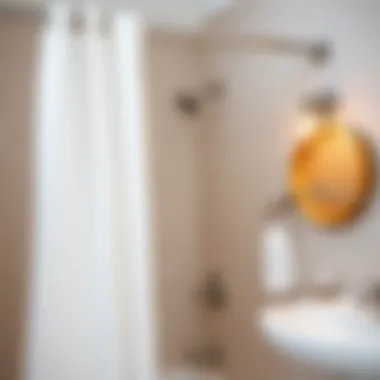Choosing the Best Tension Shower Curtain Rods for Tile Bathrooms


Intro
Selecting the right tension shower curtain rod for a tiled bathroom can seem like a simple task at first glance. However, dive deeper, and it quickly turns into an intricate dance of functionality and style. With tiles often dominating the aesthetic of a bathroom, the right curtain rod not only serves a practical purpose but also becomes a visual statement. This guide aims to cut through the noise and provide homeowners, interior designers, and DIY enthusiasts with a thorough examination of what to consider when choosing the optimal tension shower curtain rod for their unique spaces.
The significance of such a selection cannot be understated; a well-chosen rod enhances the overall visual appeal while ensuring durability and ease of maintenance. Factors like the rod's material, installation technique, and compatibility with tile surfaces play pivotal roles in this decision. Let's explore these elements in detail, ensuring you walk away with the knowledge needed to make an informed choice tailored to your bathroom's needs.
Understanding Tension Shower Curtain Rods
When it comes to bathroom aesthetics and functionality, tension shower curtain rods might not always be the first thing that springs to mind. However, these rods are essential components in any tiled bathroom, providing both practical support and style. Understanding tension shower curtain rods is critical for homeowners, designers, and decorators who want to create an inviting and practical space.
Definition and Functionality
A tension shower curtain rod is a type of rod that relies on tension to hold itself in place, rather than requiring permanent installation with screws or brackets. This feature allows for easy adjustment and installation, which is especially advantageous in tiled bathrooms where drilling holes may compromise the tiles.
Typically made from materials like stainless steel or plastic, these rods expand or contract to fit snugly between two parallel surfaces, like the walls of a shower stall. The beauty of a tension rod is in its simplicity; it can be installed in mere minutes and doesn’t require any specialized tools or skills.
For example, if you're looking to create a seamless look in your tile bathroom, opting for a tension rod means you won’t have any visible hardware interrupting the clean lines of your tiles. This kind of rod can be both functional and a subtle statement of style.
Advantages Over Traditional Rods
Tension shower curtain rods come with a variety of benefits that make them a preferable choice for many. Here are some key advantages:
- No Wall Damage: Unlike traditional rods that need to be drilled into the wall, tension rods don't leave marks or require repairs when removed. This is invaluable for rented spaces or when a change is desired.
- Flexibility: If you ever change your mind about the shower layout or want to update your decor, tension rods can easily be moved or replaced without any hassle.
- Versatile Designs: They come in numerous designs and finishes, allowing you to customize the look to match your bathroom’s decor.
- Quick Installation: Setting it up is a straightforward process. Just adjust the length, place it between the walls, and you’re good to go. This is a huge time-saver for busy households.
- Cost-effective: Usually less expensive than traditional rod setups, tension rods offer a budget-friendly option for hanging your shower curtains, especially when you consider the cost-saving benefits of not needing to repair tiles.
In summary, tension shower curtain rods are not just practical but can elevate the overall aesthetic of a tiled bathroom. Choosing the right rod involves understanding these advantages and considering how they align with your specific needs.
Compatibility with Tile Surfaces
When selecting a tension shower curtain rod for a tiled bathroom, ensuring compatibility with the surface is as critical as picking the right style or material. Unlike a standard wall, tiles introduce a unique set of considerations that can influence the performance and longevity of the rod.
Understanding Different Tile Types
Tile surfaces vary in composition, finish, and texture, making thorough knowledge essential. Here are some common tile types found in bathrooms:
- Ceramic Tile: Durable, easy to maintain, and generally has a glazed surface. Most tension rods will work well here, but the rod's grip power might require some adjustment based on tile finish.
- Porcelain Tile: Similar to ceramic but denser and often more slip-resistant. It's crucial to check that the rod's ends can properly grip without slipping. The thicker quality of porcelain tiles can also demand a more robust rod.
- Glass Tile: Aesthetic and luxurious, but slippery. The rod ends must be equipped with rubber or silicone grips to prevent sliding, which can be problematic with lighter curtains.
- Vinyl Tile: Often used in budget-friendly renovations, it’s good to ensure the tension rod does not damage the vinyl. A rod that uses a low-pressure design would be more suitable here.
These differences can influence how securely a tension rod will hold, so knowing the specific type can help a homeowner make a more informed decision. Some rods may even come with adjustable features to enhance compatibility with certain tiles.
Surface Considerations
Not all tile surfaces are created equal, and understanding their individual nuances can save homeowners from a potential headache down the line. Here are key factors to consider:
- Texture: Smooth surfaces generally offer better grip for rod ends. However, textured tiles might require specialized grips or added fittings to ensure stability and avoid slipping.
- Height and Thickness: Tiles that are thicker may need a longer rod with more tension. If the rod is too short, it might not secure properly, leading to a less-than-desirable installation.
- Installation Method: Some tension rods use suction cups, which may not be suitable for certain textures or finishes. Traditional rubber ends can work better on rough surfaces, providing the support needed without damaging the tile.
In short, the tiles in a bathroom can affect not only the choice of curtain rod but also its performance once in place. A failure in compatibility can lead to frustration and damage, turning your beautifully tiled oasis into a troublesome space. Thus, the right rod must not only cater to aesthetic needs but also to the physicality of your tile surfaces.
"Compatibility is a partnership, not a one-sided affair. Make sure your rod and tiles get along for a harmonious bathroom space."
Materials Used in Tension Rods
When selecting a tension shower curtain rod, the material it's made from holds significant weight in terms of both performance and aesthetics. The rod acts as the backbone of your curtain setup, creating a balance between style and functionality, especially in a tiled bathroom where the right touch is crucial. A well-chosen material not only endures moisture but also complements the sleekness that tiles provide. Homeowners, designers, and decorators alike should weigh the advantages and disadvantages of various materials to ensure a solid choice.
Metal vs. Plastic Rods
In the world of tension shower curtain rods, the debate between metal and plastic is a hot topic. Metal rods, typically constructed from stainless steel or aluminum, deliver a robust performance. They can withstand considerable force and typically have a higher weight capacity, which is especially beneficial for those with heavier curtains. On the downside, these rods may be prone to rusting if not properly treated, making them a less optimal choice for especially humid environments if they aren’t treated with a protective coating.
Conversely, plastic rods offer the advantage of being lightweight and rust-resistant. They’re also often less expensive than their metal counterparts. However, they may not be able to support heavy shower curtains, which can limit your design choices. For those who prefer a minimalistic or lightweight curtain fabric, plastic rods can serve admirably, but they might not stand the test of time quite as well as metal options.
When considering which material to choose, think about you’re specific needs: if durability is your main concern, metal might be the way to go. But if you’re looking for ease of installation and cost-effectiveness, a plastic rod might just do the trick. In the end, your decision will hinge on balancing the pros and cons of these materials based on your bathroom's unique environment and your aesthetic preferences.
Durability and Aesthetics
Durability and aesthetics go hand in hand when it comes to selecting the right tension shower curtain rod. The material not only needs to withstand the daily wear and tear of a humid bathroom but also should appeal to your design sensibilities. Metal rods present a striking appearance that often feels more upscale, making them a popular choice among those who prioritize style. A brushed nickel finish or a matte black steel rod can serve as a stunning visual accent that enhances the overall bathroom decor.


Plastic rods, while less visually striking, come in a variety of colors and finishes nowadays. This versatility means they can blend seamlessly into various decor styles, from modern to whimsical, without causing a visual disturbance. However, the perception of plastic being less luxurious can lead to fewer design choices that match well with upscale aesthetics.
To ensure that the chosen rod complements your tiled bathroom theme, consider factors such as:
- The color of your tiles
- Existing fixtures in the space
- The style of your shower curtain
- Overall theme—modern, rustic, minimalist, etc.
Ultimately, a well-chosen rod will not only uphold its integrity over time but also contribute positively to the ambiance of your bathroom, merging the lines between function and beauty. Because, let’s face it, nobody wants a bathroom that looks like a patchwork of mismatched elements.
Key Features to Look For
When strolling through the aisles or browsing online for the perfect tension shower curtain rod, it's easy to get lost in the multitude of choices available. However, not all rods are created equal, and understanding certain key features is crucial for ensuring a good fit for your tile bathroom. These features will not only determine the rod's functionality but also its aesthetic contribution to your space.
Weight Capacity
One of the primary aspects to keep in mind when selecting a tension shower curtain rod is its weight capacity. This is particularly important if you plan on using heavier curtains, such as those made from thick fabrics or full of added accessories like hooks and decorative elements.
A rod's weight capacity generally depends on its construction and design.
- Standard Rods: Most standard tension rods can hold up to 10 to 20 pounds.
- Heavy-duty Options: For those looking at more robust setups, heavy-duty rods can manage upwards of 30 pounds.
Knowing the weight capacity can save you a lot of hassle down the line. If the rod can't withstand the weight of your shower curtains, it may sag, bend, or collapse, possibly damaging your beautiful tile. This is especially vital in tiled areas, where any damage can be an expensive fix.
Adjustability and Length Options
Another significant feature is the adjustability of the rod. Tile bathrooms often come in various dimensions, so finding a rod that fits snugly without excessive tweaking is essential. Here are some things to note regarding adjustability:
- Extending Rods: Many tension rods come with extendable mechanisms, allowing you to customize them to fit both narrow and wide spaces. This flexibility is a major asset, giving you multiple options aligned with your bathroom's layout.
- Length Variability: Some products offer multiple length options, giving you the ability to select the perfect fit. For instance, you might need a rod that fits standard widths or one that caters to more expansive setups.
Choosing the right length ensures that your curtain hangs properly, maintaining both the look and function. Too short, and it won't cover the area effectively; too long, and you run into the risk of it being too loose, which brings its own complications.
Ease of Installation
Lastly, installation plays a critical role in the decision-making process. You want something that you can set up with minimal hassle.
Most tension rods are designed to be adjustable by simply twisting to extend or retract, making them user-friendly. However, consider the following:
- Tool-less Installation: Many rods tout easy installation that doesn’t require any tools. This is excellent for DIY enthusiasts or those who want to avoid drilling into bathroom tiles. Opting for a tool-less installation method can help preserve the integrity of your tile while providing an effortless setup.
- Instructions Provided: In addition, verify that the rod comes with clear instructions. An intuitive design coupled with straightforward guidance enhances the installation experience significantly.
Installation Techniques
When it comes to choosing the right tension shower curtain rod for a tiled bathroom, installation techniques are paramount. These not only ensure the rod's longevity but also its functionality and aesthetic appeal. Proper installation can make the difference between a reliable and an unsightly setup that compromises your bathroom's decor. With ample attention to detail during this phase, homeowners can sidestep potential mishaps that might arise later.
Preparing the Tile Surface
Before even thinking about hanging a shower curtain rod, getting the tile surface ready is crucial. This means cleaning the tiles thoroughly. A clean surface allows for better adhesion if your rod comes with any adhesive features, contributing to its sturdiness. Additionally, inspecting the tiles for cracks or weaknesses will help in identifying any potential issues that may arise after installation. Remember, cracked tiles can lead to further complications, such as moisture damage.
Step-by-Step Installation
A effective installation process not only guarantees function but also showcases a neat appearance. Here’s how to go about it:
Gathering Required Tools
Gathering tools is the first step in ensuring a smooth installation. You might think any old tool will do, yet having the right equipment on hand contributes significantly to a stress-free experience. Essential tools usually include a level, a measuring tape, and a power drill. Each of these tools serves a specific purpose, helping you bring precision to your project. The level, for instance, is especially important to check that everything is straight. Using the proper tools can greatly reduce the amount of time spent on the installation and also minimize the risk of accidental damage to both the rod and the tiles.
Measuring for Accuracy
Accurate measurements cannot be overstated. Before you start drilling or mounting, take a moment to measure both the desired height and the distance between your walls. This ensures that your shower curtain rod sits snugly in place and is positioned well. A tape measure and pencil can save you from potential headaches down the line. Missing this step can result in misalignment, making your lovely curtain rod look off-kilter and may even leave you scratching your head wondering why it wasn't working as intended.
Mounting Process
Once you’ve prepared the surface and measured everything, it’s time to tackle the actual mounting process. Depending on the specific type of tension rod, this might involve drilling holes into the tile or just pressing the rod into place. For rods that require a bit of drilling, masonry bits are commonly used to create the necessary anchors. If you find yourself working with a rod that only requires pressure, make sure to follow the manufacturer's guidelines for a solid installation. Skimping on this part can lead to the rod slipping or sagging, which is definitely not ideal for your bathroom setup.
Tip: Follow the manufacturer's carefully for installation suggestions tailored to their product.
In summary, attention to detail when it comes to installation techniques can not only enhance the appearance of your tiled bathroom but also preserve the function of your chosen tension shower curtain rod. Getting preparation and measurement right, along with the proper mounting, creates a sound setup that stands the test of time.


Maintenance and Care
Maintaining a tension shower curtain rod is as vital as selecting the right one in the first place. Proper care can extend the lifespan of your rod, ensuring that it remains functional and attractive within the context of your tiled bathroom. As tile bathrooms often face moisture and humidity, it’s essential to adopt maintenance strategies that counteract these issues and preserve the aesthetic appeal of your space. The advantages of investing a little time in maintenance include enhanced durability, reduced wear and tear, and maintaining the overall look of your bathroom.
Cleaning Recommendations
To maintain the charm of your tension shower curtain rod, establish a regular cleaning routine. Neglect can lead to the buildup of mold, mildew, and hard water stains, which do not only affect the look but might compromise the rod's functionality.
- Frequency of Cleaning: Aim to clean the rod at least once a month. In high-humidity areas, more frequent cleanings may be necessary.
- Cleaning Agents: Use a gentle cleaner. Dish soap mixed with warm water works wonders. For stubborn stains, a solution of vinegar and water can help.
- Cleaning Tools: A soft cloth or sponge will prevent scratches. Avoid abrasive cleaners to keep the finish intact.
- Technique: Wipe down the rod thoroughly, especially focusing on any hanging areas that might collect grime. Rinse with clean water to ensure all cleaning agents are removed.
- Drying: After cleaning, dry the rod with a towel to prevent moisture from encouraging mold growth.
Inspecting for Wear and Tear
Periodic inspections of your tension shower curtain rod can prevent small issues from turning into major headaches down the line. This is especially true for rods installed in tiled areas where they are subjected to various stressors. Regular checks can help homeowners identify wear and tear before it compromises safety or function. When inspecting, here are key aspects to consider:
- Visual Inspection: Look for rust spots, corrosion, or any surface damage. These can weaken the structural integrity of the rod.
- Check Stability: Make sure the rod is still firmly in place, with no signs of slippage. If it allows for movement, it may require readjustment or replacement.
- Listen for Noises: Uncharacteristic sounds during use could mean brackets or fittings are failing. This could jeopardize the whole installation.
- Wear on Finishing: Discoloration or peeling spots can indicate that the rod's coating is failing, exposing metal that is vulnerable to rust.
- Elasticity Check: If using a spring-loaded model, ensure the tension is still effective. An ineffective spring could lead to a drooping curtain, which is not only unsightly but also prone to getting caught in damp spaces.
Taking these simple yet crucial steps will help you maintain the integrity of your tension shower curtain rod, allowing you to enjoy a beautiful and functional bathroom for years to come. Remember, a stitch in time saves nine—a bit of attention can go a long way!
Popular Brands and Products
When it comes to tension shower curtain rods, selecting the right brand and model can significantly affect both performance and aesthetics in a tiled bathroom. Popular brands have established a reputation for quality and reliability through extensive testing and user satisfaction. This segment will explore notable brands and products that stand out in the market, offering features and benefits that align with various home decor styles and personal needs.
Top-ranked Models
Among the plethora of options available, a few models consistently garner positive reviews from customers. These rods not only perform well but also carry features that cater to diverse preferences.
- Moen Rods: Known for their solid construction, Moen’s tension rods often come with a sleek finish that enhances a modern bathroom decor. The ease of installation is a recurrent theme in user reviews.
- Zenna Home: This brand offers a range of models that include flexibility in dimensions and finishes, allowing homeowners to mix and match with their tile designs. Their rods typically have a rust-resistant coating which is a big advantage in moist environments.
- InterDesign: Celebrated for their variety and affordability, InterDesign features both tension and standard rods. Their products often include innovative designs that combine function with style, appealing to many decorators.
- Umbra: Known for their captivating designs, Umbra’s tension rods add a touch of creativity. Their products often feature materials that are designed to not only hold weight but keep the rod securely in place, providing peace of mind to users.
Choosing from these leading brands, homeowners can find models that provide a balance between functionality, aesthetics, and cost, ensuring their tiled bathrooms remain both practical and stylish.
Comparative Analysis
Having recognized some top models, it’s vital to weigh the advantages of each brand to make a well-informed decision. Here are a few comparative factors to consider:
Design and Aesthetics
- Moen tends to lean towards minimalistic designs, making them suitable for contemporary settings.
- Zenna Home, on the other hand, offers more traditional styles that might suit classic or rustic decor.
Installation and Maintenance
- Moen often highlights simple installation processes, appealing to DIY enthusiasts. Umbra, however, comes with unique design features that might require more careful installation.
- When it comes to maintenance, Zenna Home is often praised for materials that are easy to clean and resistant to wear over time, a blessing for busy households.
Price Range
- While Zenna Home provides budget-friendly options, Umbra often falls into a higher price bracket due to its trendy designs. Think about your budget and whether the additional features justify the cost.
"The best choice lies in understanding your specific needs—be it ease of use, aesthetic appeal, or longevity,"
Marilyn, a professional decorator, advises her clients.
Choosing the right tension shower curtain rod involves considering both brand reputation and specific product features. Knowing the strengths and weaknesses of different models empowers homeowners to secure a rod that not only fits their practical needs but also elevates the overall ambiance of their bathroom.
Cost Considerations
Selecting a tension shower curtain rod for a tiled bathroom involves more than just aesthetics; it's a matter of balancing functionality and budget. Understanding the cost implications associated with various options can significantly influence your decision. When home improvement projects arise, particularly in spaces like bathrooms that need both practicality and style, accounting for cost considerations becomes crucial.
Why Cost Matters
Cost is often the primary factor that influences what consumers choose. While it's tempting to go for the lowest-priced option available, especially if you're on a tight budget, the long-term implications of such choices can be unsettling. A cheaper rod might save a few bucks upfront but could lead to issues down the line, such as difficulty in installation, lack of durability, or even damage to your tiles.
When evaluating tension rods, several elements come to the forefront regarding costs:
- Material Quality: Different materials can affect price. Metal rods often cost more than plastic counterparts. However, metal tends to be more durable, making it a wise investment for long-term use.
- Brand Reputation: Established brands may charge a premium for their products, but they may also offer better warranties, customer service, and reliability.
- Features: Adjustable rods or those with special finishes will typically come at a higher price. Deciding which features are essential helps in budgeting.
Understanding these aspects of pricing can lead you towards a more informed purchasing decision.


Budget-friendly Options
Affordable doesn’t need to mean cheap or flimsy. There are numerous cost-effective options for tension shower curtain rods that maintain a decent balance between quality and price. Here are some recommendations on how to find a budget-friendly yet effective option:
- Material Selection: Look for plastic or coated metal rods. These are generally less expensive than pure stainless steel or other high-end materials, yet they often perform adequately in moisture-rich environments.
- Basic Designs: Opt for simpler designs that do not include additional features like decorative ends or complex mounting systems. Basic rods accomplish the job without unnecessary frills that can inflate the price.
- Sales and Discounts: Keep an eye out for sales, particularly during holiday seasons. Many retailers offer significant discounts that can make premium options more accessible.
A little patience and research can go a long way when it comes to snagging budget-friendly tension shower curtain rods.
By focusing on these aspects, you can find a rod that fits your budget without sacrificing too much in terms of quality or style.
Investing in Premium Products
When it comes to making home improvements, sometimes it pays to invest in higher-quality products. A premium tension shower curtain rod might make a larger dent in your pocketbook, but there are considerable benefits you should consider:
- Durability: Higher-end rods often use better materials, making them more resistant to wear, rust, and other forms of deterioration. For instance, solid brass or quality stainless steel rods are more durable than standard plastic, providing a long-lasting solution.
- Design and Aesthetics: Premium rods frequently come with design features and finishes that can elevate the overall appearance of your bathroom. A well-designed rod can serve as a stylish accent that complements your tiled space.
- Warranty and Support: Investing in premium products usually comes with the backing of superior warranties and customer support, which can be invaluable if you encounter any issues.
When you're spending more for a premium product, you can often find advanced features, like unique bracket systems that simplify installation or rods that expand and contract easily without compromise to structural integrity.
Ultimately, whether you opt for a budget-friendly option or a premium product, it’s essential to weigh costs against the long-term value and functionality of the tension shower curtain rod. By prioritizing quality and understanding the nuances of cost considerations, you can create a tiled bathroom that not only looks great but works beautifully for years to come.
User Reviews and Feedback
Understanding what users think about tension shower curtain rods is crucial. The insights from consumer experiences can guide prospective buyers in making informed decisions. Reviews often highlight real-life issues and advantages that marketing materials may overlook. For instance, elements such as ease of installation, durability, or whether the rod holds up against the moisture in a bathroom environment are often well detailed.
Given the unique challenges presented by tiled surfaces, user feedback becomes even more significant. Individuals who've installed these rods know firsthand how well they work in practice, especially in terms of fitting securely without damaging tiles or requiring additional hardware. Evaluating these reviews provides a sense of reassurance, allowing potential buyers to gauge compatibility and performance based on authentic experiences.
Evaluating Consumer Experiences
When diving into consumer reviews, it’s essential to note the authenticity and specifics of their experiences. Look out for details such as:
- Installation Ease: Many users share if the installation was a breeze or a real headache.
- Durability: Feedback on how long the rod has lasted under normal use can reveal a lot about its quality.
- Adjustability: Some users might appreciate how adaptable the rod is, especially if they have high or low ceilings.
- Aesthetic Appeal: Does this rod clash with the existing decor? User opinions can often help picture if the rod fits visually in a space.
To gauge user sentiment, sites like Facebook and forums such as Reddit can provide comprehensive insights. One can find threads where users exchange experiences or recommendations, making it a helpful platform for prospective buyers.
Common Complaints and Praise
Reviews often reveal a mixed bag of opinions. Common complaints typically include:
- Slippage: Some users report that the rod may not grip well and ends up sliding down, particularly when hung with heavier curtains.
- Damage to Tiles: Users may worry about the potential scratches or damage to their tiles during installation or from movements over time.
- Weight Capacity: A few users find that the rod does not hold as much weight as advertised, specifically when dealing with heavier fabrics.
On the flip side, praise frequently touches on:
- Stability: Many users appreciate that their rods remain firmly in place, providing peace of mind.
- Aesthetics: A good number of reviewers fall for the design, adapting it into their bathroom without a hitch.
- No Drilling Required: Convenience is a key aspect mentioned positively, as many highlight the no-drilling feature, making it easy to install and remove without any damage.
Ultimately, filtering through user reviews allows homeowners, designers, and decorators to make choices that align with their unique needs. A thorough analysis of feedback helps pinpoint which tension rods may offer the best balance of style, functionality, and durability in a tiled environment.
Final Recommendations
Selecting the right tension shower curtain rod for a tiled bathroom goes beyond mere aesthetics; it's about finding a balance between functionality and style. After diving into various aspects of tension rods throughout this article, we can now synthesize what you’ve learned and offer some final recommendations to ensure your choice meets both visual and practical needs.
Tension rods can enhance the look of a bathroom while also providing essential utility. But is every rod suitable for every bathroom? Not even close. Therefore, it’s critical to consider specific elements unique to your space.
Tailoring Choices to Your Space
When it comes to bathrooms, every detail counts. You have to take into account not just the size of your tile or the height of your ceiling but also how you plan to use the space. An adjustable tension rod can be versatile, but if your tiles have a rough surface, you might want something with a more rubberized grip to avoid slipping. Consider these crucial points:
- Tile Material: Porcelain, ceramic, or glass tiles? Each surface will interact differently with various rod materials.
- Spacing: Measure from the floor to the highest point where you want the curtain to hang. Too high or too low can impact not only aesthetics but functionality as well.
- Style of Curtain: A heavy shower curtain might demand a sturdier rod, while lighter fabrics could suit a more delicate option.
This tailored approach ensures that your tension rod not only fits but complements the bathroom’s overall design and ethos. Don’t shy away from experimenting with colors and finishes that might pop against the tile!
Making the Perfect Selection
So, how does one make the perfect selection after careful consideration of space? It’s about collating all the valuable insights gleaned and translating them into a purchasing decision. Start with these guiding principles:
- Evaluate Your Needs: Are you mainly focused on aesthetics, or is functionality the priority? Making a definitive choice here will direct your search.
- Read User Reviews: Tap into the experiences of those who have gone before. They often offer unsuspected gems of wisdom about durability, ease of installation, and long-term performance.
- Brand Reputation: Opt for brands that have established themselves in the market. Often, longevity and reliability stem from companies that have garnered consumer trust over time.
In the end, the best tension shower curtain rod is one that embodies the harmony of functionality, durability, and aesthetic appeal that suits your personal style. Remember, your bathroom isn’t just a place to cleanse; it's your personal oasis, so choose a rod that resonates with your vision and needs.
"A well-chosen tension shower curtain rod can elevate your bathroom from merely functional to beautifully cohesive."
By following these recommendations, you’ll be equipped to make a more informed choice, ensuring that your tension shower curtain rod aligns with your bathroom’s unique vibe.



